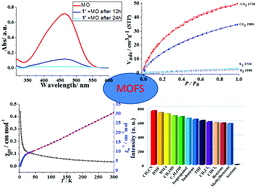Fluorescent sensing and selective adsorption properties of metal–organic frameworks with mixed tricarboxylate and 1H-imidazol-4-yl-containing ligands†
Abstract
Herein, two metal–organic frameworks (MOFs), [Co4(μ3-OH)2(L)(BTB)2(H2O)3]·5.6H2O (1) and [Cd3(L)2(BTB)2(μ2-H2O)]·7.4H2O (2), based on 1,3-di(1H-imidazol-4-yl)benzene (L) and 1,3,5-tri(4-carboxyphenyl)benzene (H3BTB), respectively, have been achieved. Compound 1 is a porous three-dimensional (3D) framework with butterfly-like tetranuclear clusters as 7-connected nodes, and compund 2 is a 3D net with a different topology. Remarkably, compounds 1 and 2 exhibit selective adsorption of CO2 over N2 and methyl orange (MO) dye molecules. Magnetic measurements reveal that there are antiferromagnetic interactions within the tetranuclear cluster in 1. Furthermore, 2 was well-dispersed in different solvents, and their luminescent properties were investigated, and the results indicated that 2 could be considered as a potential luminescent probe for the detection of ketone molecules.



 Please wait while we load your content...
Please wait while we load your content...